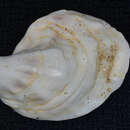Diagnostic Description
provided by FAO species catalogs
Shell solid, inequivalve left (lower) valve convex, right (upper) valve tending to be flat, though often bent sitting within the left; inequilateral, beaks and umbones not prominent, tending to be broadly oval in outline but often distorted. Ligament internal, attached to a central triangular pit, with lateral extensions. Sculpture of concentric ridges and lines with a few irregular radiating ribs on the left valve which do not normally meet or indent the margin. Hinge line without teeth in the adult. Shell margins smooth. Colour white, dirty white or brown, sometimes with dark purple markings. Periostracum thin, dark brown; interior of shell white; adductor muscle scar near the posterior margin, a deep purple or red-brown.
- Poutiers, J.M.- 1987 Ostreidae. In: W. Fischer; M.-L. Bauchot (eds.) Fiches FAO d'Identification des espèces pour les besoins de la pêche. (Révision 1). Méditerranée et mer Noire. Zone de Pêche 37. Vol. I. Végétaux et Invertébres. Rome, FAO, 447-452.
- Stanley, J. & M. Sellers - 1986Species Profiles: Life Histories and Environmental Requirements of Coastal Fishes and Invertebrates (Gulf of Mexico), American oyster. U.S. Fish and Wildlife Service Biol. Rep. 82 (11.64). 25 pp.
- Tebble, N. - 1966British Bivalve Seashells. A Handbook for Identification, London Trusties of the British Nuseum (Natural History): 212 pp.
Distribution
provided by FAO species catalogs
Western Atlantic Ocean from the Gulf of Mexico and Panama to South Maine, and in the Gulf of St. Lawrence. Imported in Europe (British Islands to to Bay of Biscay) prior to 1939, but the colonies seem to have some difficulties in proliferating. Caught occasionally, with bottom trawls and dredges, in the Adriatic Sea (Mediterranean Sea).
Size
provided by FAO species catalogs
Measuring to 25 cm cm from hinge-line to the opposite margin; common 8-18 cm.
Brief Summary
provided by FAO species catalogs
Sessile (cemented to the substrate on its left valve).Oysters favor estuaries and sounds with salinities between 5 and 30% and are intolerant of prolonged exposure to fresh water or marine salinities. Filter feeder.Also they are found in shallow areas of tidal to subtidal zones (between 0,5-75 meters),prefer a firm substrate (pilings, hard rock bottoms, and substrates firmed with the oyster shells of previous generations). The American oyster is an epibenthicsuspension feeder, ingesting a variety of algae, bacteria, and small detrital particles. Fecal and pseudofecal material is important in sediment production and deposition, providing sites for remineralizing bacterial action, and as food source for deposit feeders.Swimming larvae have positive phototaxis, which becomes negative with increased temperature.
Benefits
provided by FAO species catalogs
American oysters are prominent members of the benthic community in Chesapeake Bay (USA) and contribute substantially to the economy of the region. Oysters have recently experienced severe declines in abundance. Intense fishing pressure, loss of habitat, and water quality degradation have been blamed for declines in the abundance of this species. Its meat is not highly sought after by European consumers. Resource very important in Gulf of Mexico (Tamaulipas, Veracruz and Tabasco). The total catch reported for this species to FAO for 1999 was 132 207 t. The countries with the largest catches were USA (89 714 t) and Mexico (39 268 t). Marketed fresh.

